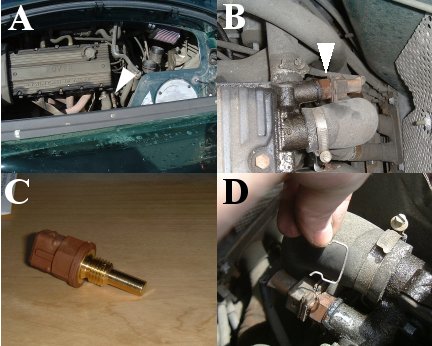
|
Related problems: overheating |
Overheating and steam erruptions that mimick those seen by head gasket failure can be seen following a number of unrelated cooling system faults, including:
Non-functioning of radiator fan
This results in a similar pattern of overheating as a failed ECU temperature sensor (as described below). There are three checks to perform:
Check 1: Fuse 6
The first step is to ensure that all the fan fuses are intact. The first of these is the 15Amp fuse in the front bonnet compartment - fuse number 6 (pictured opposite). Note that there is an error in the owner's handbook (certainly the version that I've got - RCL0049ENG) where the fuses are numbered in the wrong order... the correct order is shown opposite, where the left-most fuse is number 1, and the right-most fuse is number 7.
Remove fuse, and see if the element is intact. If not, replace.
Check 2: Fuse 15
The second fuse to check is fuse #15 found in the passenger compartment fuse box - located under the steering wheel.
Again, there appears to be an error in both the handbook and the workshop manual, in that the rating is quoted as being 20Amps, whereas on non-airconditioned cars, the rating is actually 10Amps.
Remove fuse and check that the fuseable element is intact. If not, replace.
Check 3: ECU temperature sensor
If BOTH fuses are intact, now go on to check the temperature sensor, as described below, before checking the radiator fan wiring (difficult to get to: the front bumper needs to be removed).
ECU temperature sensor failure
When the ECU temperature sensor fails, the temperature is characteristically associated with foward velocity; faster you travel, the cooler the engine runs...
The most likely cause of a failure of this type is the malfunction of the ECU temperature sensor or its electrical connection to the engine management system. To check, open the engine inspection lid, and examine the following parts. A replacement sensor (part # GTR206) costs less than 11 GBP including VAT, so replacement is a sensible precaution.
A quick and easy check of the radiator fan circuit is to remove the sensor with the engine running. If the engine is still cold, removing the sensor (which increases the resistance of this circuit to infinity) triggers the radiator fan, and drops the engine speed (the engine management is fooled into thinking that the engine is hot, when it is in fact, still cold). If fan IS triggered, then the problem lies with the ECU temperature sensor. If not, then check the radiator fan wiring, and the fan motor itself.
Replacement of ECU temp sensor/ cleaning of contacts
 A: location of sensor at front left corner of engine cylinder head (arrowed) B: close up of sensor (brown coloured, arrowed). C: what the sensor looks like (part # GTR206) D: removing the wiring loom requires release of a circlip- careful not to loose! |
![]() CAUTION: Replace sensor only when engine and
coolant are cold. Unscrew and replace with new sensor sparingly smeared with a gasket
compound.
CAUTION: Replace sensor only when engine and
coolant are cold. Unscrew and replace with new sensor sparingly smeared with a gasket
compound.
| Before investing in a new sensor, a
sensible first step is to clean the electrical contacts between the sensor and loom plug.
It appears that these connections are susceptible to dirt ingress leading to degradation
of electrical connection (and hence measured resistance of the sensor). A wide range of electrical contact cleaners are available - I used the
product shown opposite, available on line from Maplin's.
Worked a treat! |
 |
Similar faults can occur with the dashboard temperature guage making it under-read coolant temperature. Its location is immediately below the ECU temp sensor mounted in the vertical plane.